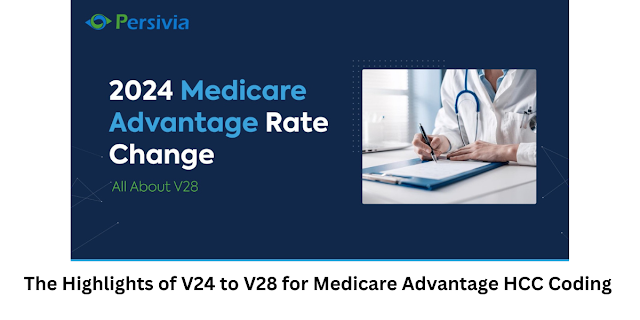The Highlights of V24 to V28 for Medicare Advantage HCC Coding
Version 24 to Version 28 represents the most recent and substantial change in the Medicare Advantage HCC Coding. Medical Advantage Organizations (MAOs) and healthcare organizations must consider the broad effects of this change.
We must first realize the relevance of HCCs in Medicare Advantage to fully understand the change from V24 to V28. To forecast future costs and payments for patients in Medicare Advantage plans, HCCs were created by Medicare. Concerns have been raised about upcoding in these programs, which could result in excessive payments. The Centers for Medicare & Medicaid Services (CMS) intends to solve these issues by enhancing the HCC Coding methodology.
The Medicare Advantage Reimbursement Model
Shared risk between providers and payers underpins the Medicare Advantage (MA) reimbursement paradigm. It is based on a risk adjustment model that forecasts future expenses using historical claims data, resulting in provider payments. After the industry adopted ICD-10-CM codes in 2015, this model, which was initially based on ICD-9-CM codes, continues to use ICD-10-CM codes for payments.
Transition Management Between The Two Model Versions
Through the CMS-HCC risk adjustment model, CMS has designed a phased transition strategy from V24 to V28 for Medicare Advantage. By 2026, 100% of payments will be made using Version 28, after which the transition will stop. The problem for providers will be handling two model versions at once, each with unique HCC inclusion and RAF values.
Highlights of The Latest Medicare Advantage HCC Coding Version 28
The risk adjustment model has undergone numerous significant revisions and improvements as of V28:
Renaming and Renumbering of HCCs: Version 28 includes a thorough renaming and renumbering process for HCCs, enhancing organization and clarity.
Increase in Total Number of HCCs: In edition 28, there are 115 HCCs, up from 86 in the previous edition. This covers recently discovered HCCs like HCC 35 Pancreas Transplant Status.
Drop in Number of ICD-10-CM Codes Designated as HCCs: V28 simplifies the risk adjustment procedure by axing about 2,000 ICD-10-CM codes that were previously labeled as HCCs.
Changes in Coefficient Risk Adjustment Factors (RAF): It introduces changes in the CRAF values for particular HCCs, affecting patient risk scores.
Consolidation of Diabetes Categories: Multiple diabetes categories have been combined into a single category, which has an impact on risk scores for diabetic patients.
Removal and Addition of Diagnosis Codes: Last but not least, it eliminated 2,294 diagnosis codes that no longer correspond to a payment HCC and added 268 diagnosis codes that weren't in Version 24.




Comments
Post a Comment